Juno season has started again.
Here some pictures to show you the variability of iris rosenbachiana:
photo 1-2 = "Deep Purple"
3-4 = "Varzob"
5 = "Harangon"
6-7 = "Tovilj-Dara"
8-9 = unnamed selection from the wild
Comments
Re: Iris 2011
Hello Luc, welcome to the NARGS Forum; thanks for kicking off Iris 2011 with a bang! The Iris rosenbachiana cultivars are splendid. It'll be a couple more months before we see such things over here (not that I have Iris rosenbachiana), but it is most refreshing to see these Iris delights on this cold winter morning.
Re: Iris 2011
I thought I'd give it a try here as well ! ;)
Couldn't refuse Marc McDonoughs friendly invitation ! ;)
Here's two Juno Iris :
I. rosenbachiana 'Harangon' in full swing
Iris x sindpers
Re: Iris 2011
Gorgeous images! Please consider adding some to our image gallery!
With 5 feet of snow in my garden, I won't be seeing any iris bloom anytime soon.
Re: Iris 2011
Spectacular! How long does each individual flower last?
And would that be pretty much standard across the Juno species?
Re: Iris 2011
OMG... the rosenbachiana!!!!!!!!!! :o :o :o :o :o Stupendous!! :o
Re: Iris 2011
Thanks for the compliments guys !
Rick, each flower (depending on the weather) lasts for about a week.
The rosenbachiana I'm showing had one flower open on February 3rd - (you can see it's shrivelled remainders in the low left corner of the picture) - since then 3 new flowers devellopped - flowering will end in about one week from now I guess)
Todd,
I'll have a look where your image gallery is. ;)
Re: Iris 2011
Luc, I think I like Iris rosenbachiana 'Harangon' best of all, simply gorgeous. These iris have the types of flowers one wants to keeping staring at, taking in the sculpted intricacies of the blooms, contemplating the dramatic coloration and markings.
I have posted photos of my "Juno" Iris in the past, I will add some link to these. When visiting the gardens of John Lonsdale in Pennsylvania, USA, the most striking aspect of this truly outstanding garden, if that he "pushes the envelope" so to speak, and grows things outdoors that we often think of as ungrowable outdoors. Such inspiration. This is where I saw many Juno iris being grown outdoors, even seeding around, and there were Oncos too. Those that I have grown all came from John.
Not only is his garden magnificent, but so too is his web site and extensive photo galleries. Here are links to John's Edgewood Gardens web site, his Iris subgenus Scorpiris gallery, and the last link to the floral candy of Iris rosenbachiana:
http://www.edgewoodgardens.net/
http://www.edgewoodgardens.net/Plants_album/The%20Plants%20-%20%20Comple...
http://www.edgewoodgardens.net/Plants_album/The%20Plants%20-%20%20Comple...
Re: Iris 2011
No magnificent Juno's, like from the two Luc's, here...just some reticulate Irisses which were flowering here in the last couple of weeks:
Iris 'Alida'
Iris 'Beautiful Day'
Iris 'Blue Ice'
Iris danfordiae
Iris 'Evening twilight'
Iris 'George'
Iris 'Gordon'
Iris 'Harmony'
Iris histrio
Iris histrioides 'Angel's Eye'
Re: Iris 2011
And a couple more:
Iris hyrcana
Iris 'Katherine Hodgkin'
Iris 'Morning Glow'
Iris 'Pixie'
Iris 'Vivacious Beginnings'
Re: Iris 2011
Nice collection there Wim
Re: Iris 2011
Excellent plants to give the N. American winter some colour Wim !
Re: Iris 2011
Wim, quite an eyeful of gorgeous Iris there. There are a few with names I don't know; are 'Evening Twilight', 'Morning Glow', and 'Vivacious Begginings" McMurtie hybrids? And do you have any brief info on there beautiful blues: 'Beautiful Day', 'Blue Ice', and 'Alida'?
Something I want to document later in the season, is how people cope with the greatly lengthening summer foliage on the retics. This past summer I intended on photographing the leaves on some of these, that I have measured as reaching 3' (1 meter) in length in past summers. But as it turned out, with our severe drought, they didn't get that long and dried up much faster than normal. I did take a picture (I think I did) of a small massed planting of Iris 'Katherine Hodgkin' where it makes a very messy mass of long foliage afterwards, I'll see if I can find it. It is my one criticism of the otherwise beautiful retics, and to a lesser extent some of the Chinese Iris like I. koreana and minutoaurea, that the foliage grows so long after flowering.
Re: Iris 2011
Iris minutoaurea foliage does not go wimpy-floppy for me. It does lengthen after flowering, but not to the extent you showed on the forum (I don't remember if it was here or SRGC). But my plants have more room than the one in your pic, Mark.
Re: Iris 2011
Iris minutoaurea foliage does not go wimpy-floppy for me. It does lengthen after flowering, but not to the extent you showed on the forum (I don't remember if it was here or SRGC). But my plants have more room than the one in your pic, Mark.
In the case of I. minutoaurea, for me the foliage does not go wimpy-floppy; it stands upright, but gets to about 16" long, whereas the plant in flower is barely 2" tall.
In my photos posted on another thread (see below) this Iris is being crowded out, so this summer I relocated the encroaching Epimedium, to allow this fine Iris to expand unencumbered. I wonder too, if there are more than one form of this Iris going around; mine came from Darrell Probst at Garden Vision Epimediums. Rick, where is your plant from?
http://www.srgc.org.uk/smf/index.php?topic=5627.msg156824#msg156824
http://www.srgc.org.uk/smf/index.php?topic=4736.msg128032#msg128032
Re: Iris 2011
A mistake on my part, my blooms are 2.5 inches high, certainly not 4!
But foliage is never longer than 12 inches. One plant was given to me by a Chapter member who grew it from seed from the NARGS seed ex labeled as Iris sanguinea. (What a wonderful surprise!) The other came from Betty Ann Addison's nursery, Rice Creek Gardens, here in Minnesota. It was sold to me as Iris arenaria. I don't have a clue where she got it. Both plants behave the same.
Re: Iris 2011
Thanks Rick... regardless, it's a wonderful little Iris. This year I plan on dividing it up into as many pieces as possible. Let's hope we have a better summer than the 2010 ultra-drought year.
Re: Iris 2011
Wim, quite an eyeful of gorgeous Iris there. There are a few with names I don't know; are 'Evening Twilight', 'Morning Glow', and 'Vivacious Begginings" McMurtie hybrids? And do you have any brief info on there beautiful blues: 'Beautiful Day', 'Blue Ice', and 'Alida'?
Something I want to document later in the season, is how people cope with the greatly lengthening summer foliage on the retics. This past summer I intended on photographing the leaves on some of these, that I have measured as reaching 3' (1 meter) in length in past summers. But as it turned out, with our severe drought, they didn't get that long and dried up much faster than normal. I did take a picture (I think I did) of a small massed planting of Iris 'Katherine Hodgkin' where it makes a very messy mass of long foliage afterwards, I'll see if I can find it. It is my one criticism of the otherwise beautiful retics, and to a lesser extent some of the Chinese Iris like I. koreana and minutoaurea, that the foliage grows so long after flowering.
Thanks McMark,
'Evening Twilight', 'Morning Glow', 'Vivacious Beginnings', 'Beautiful Day' and 'Blue Ice' are all McMurtrie hybrids (all of them Iris sophenensis x danfordiae crosses) bought from Janis Ruksans last year. 'Alida' is a selection taken from I. 'Harmony'.
Leaves up to 1 meter :o :o The max we ever get is 20-25 cm. If you place them near to herbaceous perennials the leaves get covered in a month or two.
Re: Iris 2011
Wim,
I too echo Mark's question re the unknown ones. Interestingly, I grow pretty much all you pictured bar the McMurtrie hybrids here, or at least have done. The 5 names you showed as his are the 5 that I'd never seen. ;D It is also interesting that you say that 'Alida' is a selection from 'Harmony'. I've thought them very similar, at least in my garden, and wondered about the naming.
Mark,
Leaves a 1m!! :o :o Ours never get anything like that, although Hermodactylus tuberosus does. None of the retics ever get leaves more than maybe 30cm here, in many cases not even near to that.
Rick,
Getting minutoaurea instead of sanguinea was a bit of luck. I've only ever seen pics of the minutoaurea myself. Not that I'd sneeze at sanguinea for that matter, as I loved it when I used to grow it maybe 15 years ago. Such an excellent intense purple colour to it, or at least the form I had of it (which is the only one I've ever seen in person, so I have no idea whether it was standard or not). Of course, it has been 15 years since I last saw it, so absence may have made the heart grow fonder, or at least the memory hazier!!? ;D ;D
Re: Iris 2011
Does anyone grow Iris lazica? I have a large clump that I badly need to split, when would be the best time to do it?
Re: Iris 2011
David,
I've butchered my I. lazica in autumn in the past without a problem, in fact I think I've taken pieces off mine at various times of the year without any problems. I love it's chunkiness compared to the unguicularis, and the very different green of the leaves. I've found it hardy here from shade to full sun. Mine existed for many years in a small pot amongst grass at our old property when it was rented out. After a couple of years of sitting amongst the grass in it's pot I discovered it still alive and more or less green, despite the other pots of other things like daffodils etc also hidden in said grass all dying. This was in total blazing sunshine (other than perhaps some light cover from some of the grass at certain times of year?) without any artificial watering at all. I was amazed at how hardy it was.
Re: Iris 2011
David and Paul, aren't you going to tempt us with some nice photos of I. lazica?
Re: Iris 2011
Mark,
Happy to oblige. Not brilliant pics, but you get the idea. ;D
Iris lazica in my garden. The pics were technically taken in 2005 and 2006, but they were prepared today, hence the watermark for 2011. :) These pics were taken in September in those years.
Re: Iris 2011
Nice show everybody !
I've got another Juno flowering at the moment : Iris nusariensis from Syria
On the second picture you can see a second flower bud developping nicely... :)
Re: Iris 2011
That's a beauty, Luc.
Re: Iris 2011
Nice show everybody !
I've got another Juno flowering at the moment : Iris nusariensis from Syria
On the second picture you can see a second flower bud developping nicely... :)
Wonderful Luc,
it reminds me of the color which the sky of Belgium often has ;)
Re: Iris 2011
Excellent plants to give the N. American winter some colour Wim !
Thanks Luc,
here are two more which were flowering today:
Iris 'Cantab'
and Iris 'J.S Dijt'
Re: Iris 2011
IRIS lazica
First of all I should say that I had written most of what follows and prepared the pics before I had seen Paul's pics higher up the page and thanks Paul for the splitting advice.
Let's have a look at what Brian Mathew says about Iris lazica in "The Iris"
Well, it grows about 15-25cm in height (roughly 6-10 inches) !! (see later); is March flowering (see later); is endemic in the Black Sea coastal regions of south west Caucasia and north east Turkey as far west as Giresun; and it grows on shady banks but is in damp conditions for most of the year.
My plant grows in full sun (when we get some) and boy does it get damp conditions for most of the year! That's maybe why my plant forms a rough square of about 36 inches(91.4cm) and is about 30 inches (76.2cm high) and that's why it needs to be split :) As far as flowering is concerned I've had it in flower in August; it's been in flower in December and the pictures of it in flower below are from February 2008. Last week it had four flowers on it but when I looked today the snails had done their worst with them.
Re: Iris 2011
David,
15-25cm high is WAY smaller than mine as well, and the clump size is about the same as yours I think. It seems to get to a certain size though and then doesn't seem to expand anywhere near the same rate after that, if that is any help. I'd be putting a shovel through it and lifting part of it out, leaving the rest of it in place if you're worried about the moving process. That way half (or whatever amount you decide) doesn't get disturbed, while you divide up the rest.
Re: Iris 2011
David,
15-25cm high is WAY smaller than mine as well, and the clump size is about the same as yours I think. .........
Glad to hear that Paul, I thought I had bought a giant! I think your spade idea is the perfect remedy.
Re: Iris 2011
David,
That way it leaves the main part of the plant undisturbed (more or less), while giving you other plants to get growing elsewhere. Once you know you've established more you can butcher the original to your heart's content. ;D ;D I'm brutal I know, but usually only with backups already established. ;)
Re: Iris 2011
Paul, when you split do you reduce the length of the leaves on the split portions please?
Re: Iris 2011
Nice show everybody !
I've got another Juno flowering at the moment : Iris nusariensis from Syria
On the second picture you can see a second flower bud developping nicely... :)
Luc, the Iris nusariensis is stunning, I've seen it on the SRGC pages, and I'm in awe of the flower color and form. I'm partial to pale smokey ice blue colors (perhaps the reason I like Globularia so much), and this Iris personifies the most pure of color schemes.
Re: Iris 2011
Paul, when you split do you reduce the length of the leaves on the split portions please?
David,
Not if there is a decent root system on it. The only time I'd cut leaves back on transplanting if there were few roots. I don't ever trim the leaves on lazica, although some years I do in early winter on the unguicularis as they start to flower.
Re: Iris 2011
Today a first flowering of a rather temperamental juno which made me quite happy: iris fosteriana.
It grows wild in the Kopet Dag (NE-Iran, NW-Afghanistan) in dryish steppe country on stony slopes which are moist in spring but very dry in summer. So the best chance of succes is cultivation in a cold greenhouse or a bulb frame where water can be withheld completely in the summer.
Re: Iris 2011
Today a first flowering of a rather temperamental juno which made me quite happy: Iris fosteriana.
It grows wild in the Kopet Dag (NE-Iran, NW-Afghanistan) in dryish steppe country on stony slopes which are moist in spring but very dry in summer. So the best chance of succes is cultivation in a cold greenhouse or a bulb frame where water can be withheld completely in the summer.
Congratulations Luc, a very nice juno. I first saw photos of this species on Kees Jan's remarkable photo gallery of plants from Kopet Dag, Northern Iran. I love the purple bracts (is that the official terminology) beneath the flowers.
Kees Jan's SmugMug photo gallery on plants of Kopet Fag, Northern Iran, 49 pages, 723 photos
http://keesjan.smugmug.com/Botanical-trips/Asia/Kopet-Dag-Mountains-NE-I...
...you can browse through the whole gallery (I did a couple of times :D), or search Iris fosteriana, with 52 photos of it!
http://keesjan.smugmug.com/search/index.mg?searchWords=Iris+fosteriana&s...
...here is one of 52 photos on this beautiful Iris:
http://keesjan.smugmug.com/Botanical-trips/Asia/Kopet-Dag-Mountains-NE-I...
Luc, did you grow yours from seed, and if so, how long to reach flowering? Looks like you have room for expanding your collection, with all those empty pots.
Re: Iris 2011
Yes, those purple bract things are interesting appendages. I don't think I have ever noticed them before, held with that aspect, on an iris.
Re: Iris 2011
Marc, this one is not from seed. It is one of the collections of Jim Archibald.
The dark purple standards are in this species turned down to almost a vertical position as is shown in the next photo.
Re: Iris 2011
Iris standards that fall... I never would have thought.
Re: Iris 2011
Iris standards that fall... I never would have thought.
An extract from the iris book by Brian Mathew with the parts of a juno flower.
Re: Iris 2011
Thanks, Luc!
And I didn't know that was the norm for Juno iris:
that the standards grow below the falls. :)
Re: Iris 2011
Wish I could grow junos in my part of the world but alas, not even bucharica lasts more than 2-3 years. I have to live vicariously through others. Thankfully we can grow the reticulata with no fuss.
Re: Iris 2011
You can find Iris (juno) aucheri with a whole range of blue flowers.
This clone has very dark blue flowers .
Re: Iris 2011
Wow, that's an intense dark color! :o :o :o Truly special.
I have a single plant of I. aucheri (regular blue) growing outdoors for the past 8-9 years, flowering nicely the first few years but I only get leaves in more recent years, I don't think these plants take too kindly to competition from neighboring plants.
Re: Iris 2011
Marc,
They need feeding in the growing season, especially potash after the flowering period.
Competition with other plants is not a good idea if you like flowers.
Re: Iris 2011
My first two Junos of the season.
Iris tubergeniana, and
Iris bucharica 'Baldschuan Yellow'
Re: Iris 2011
A dwarf variety of Iris unguicularis ssp cretensis from Mt. Ida, Crete
Luc, that is totally charming and delightfully surprising! :o :o
I love these dwarf grassy leaf types; didn't realize there was such dwarf form of I. unguicularis. I had to google to find out there is a Mt. Ida in Crete as well as in Turkey (I'm familiar with some plants from the Turkish Mr. Ida); there are several other Mt. Ida locations too.
Googling I find this species offered by a number of UK nurseries. Your plant looks more attractive than most photos I've found in my brief search, including on the Signa site:
http://www.signa.org/index.pl?Iris-cretensis
http://www.signa.org/index.pl?Display+Iris-cretensis+5
I found the species once listed on Plant Delights Nursery, listed as Zone 7, indicating it would not be hardy here. A couple other sites rate it Zone 6. Since it is a "winter grower", I'm figuring it would not grow here, although I have never tried.
http://www.plantdelights.com/Iris-unguicularis-ssp-cretensis-Perennial-W...
Re: Iris 2011
And there are those falling standards again, easily seen on the two yellow juno species. Intriguing...
And interesting to know that I. unguicularis grows for you, Mark. I don't know why, but I planted seeds of this one last year. They germinated in late summer and they are in on the windowsill now. (Sorry to say that they have been badly neglected, as I didn't think they would have a prayer here.) Now maybe there is an eensy-teensy chance!
Re: Iris 2011
And there are those falling standards again, easily seen on the two yellow juno species. Intriguing...
And interesting to know that I. unguicularis grows for you, Mark. I don't know why, but I planted seeds of this one last year. They germinated in late summer and they are in on the windowsill now. (Sorry to say that they have been badly neglected, as I didn't think they would have a prayer here.) Now maybe there is an eensy-teensy chance!
Rick, sorry to have given the impression that I am growing this species; I'm not. I always figured that being a winter grower/bloomer it would be much too tender for New England, and the zone ratings cited for the species are not encouraging. Maybe the dwarf Cretan form would have greater hardiness?
Re: Iris 2011
I saw this lovely I. unguicularis growing in a garden at Pine Knot Farm last week. It's too bad they aren't hardy for the north, the color is so pretty and the flowers are nice & big.
Re: Iris 2011
Rick, sorry to have given the impression that I am growing this species; I'm not.
Obviously, my head was somewhere else when I was (thinking I was) reading your post, Mark. ;D
Re: Iris 2011
Luc, that is totally charming and delightfully surprising! :o :o
I love these dwarf grassy leaf types; didn't realize there was such dwarf form of I. unguicularis. I had to google to find out there is a Mt. Ida in Crete as well as in Turkey (I'm familiar with some plants from the Turkish Mr. Ida); there are several other Mt. Ida locations too.Googling I find this species offered by a number of UK nurseries. Your plant looks more attractive than most photos I've found in my brief search, including on the Signa site:
http://www.signa.org/index.pl?Iris-cretensis
http://www.signa.org/index.pl?Display+Iris-cretensis+5I found the species once listed on Plant Delights Nursery, listed as Zone 7, indicating it would not be hardy here. A couple other sites rate it Zone 6. Since it is a "winter grower", I'm figuring it would not grow here, although I have never tried.
http://www.plantdelights.com/Iris-unguicularis-ssp-cretensis-Perennial-W...
The plant stays in winter under glassroof but unprotected from the cold. It is nearly evergreen with me.
I think that a rather dry and hot summer is necessary to induce spring flowering.
Re: Iris 2011
Two more juno iris starting to flower:
Iris graeberiana in one of its froms
Iris willmottiana
Re: Iris 2011
And from a different group in the iris family :
Iris flavissima
Iris tygridia
Luc, both of these are lovely Iris, glad to "meet" them. Not knowing much about them nor what Iris section they are in, I had to look them up. Still not sure what section I. flavissima is in, photos show a brighter yellow flower, although I much prefer your exquisite form with delicate markings. Found photos of a pale yellow form here (scroll down):
http://plantes-passion.forumactif.fr/t411-iris-flavissima
...and a European nursery offering a darker yellow form:
http://www.rareplants.de/shop/product.asp?P_ID=8865
...Flora of China entry:
http://www.efloras.org/florataxon.aspx?flora_id=2&taxon_id=200028168
Iris tigridia is a little beauty, I would grow that one in a heartbeat, it is section Pseudoregelia. John Lonsdale grows it outdoors, which gives some promise that it is growable outdoors here in New England, NE USA.
http://www.edgewoodgardens.net/plants_album/the%20plants%20-%20%20comple...
Re: Iris 2011
Luc, both of these are lovely Iris, glad to "meet" them. Not knowing much about them nor what Iris section they are in, I had to look them up. Still not sure what section I. flavissima is in, photos show a brighter yellow flower, although I much prefer your exquisite form with delicate markings. Found photos of a pale yellow form here (scroll down):
http://plantes-passion.forumactif.fr/t411-iris-flavissima
...and a European nursery offering a darker yellow form:
http://www.rareplants.de/shop/product.asp?P_ID=8865
...Flora of China entry:
http://www.efloras.org/florataxon.aspx?flora_id=2&taxon_id=200028168
Hey Mark,
Brian Matthew regards this species as being the same as Iris arenaria and Iris humilis.
Iris flavissima has its distribution in E-Europe.
Re: Iris 2011
Luc, both of these are lovely Iris, glad to "meet" them. Not knowing much about them nor what Iris section they are in, I had to look them up. Still not sure what section I. flavissima is in, photos show a brighter yellow flower, although I much prefer your exquisite form with delicate markings. Found photos of a pale yellow form here (scroll down):
http://plantes-passion.forumactif.fr/t411-iris-flavissima
...and a European nursery offering a darker yellow form:
http://www.rareplants.de/shop/product.asp?P_ID=8865
...Flora of China entry:
http://www.efloras.org/florataxon.aspx?flora_id=2&taxon_id=200028168Hey Mark,
Brian Matthew regards this species as being the same as Iris arenaria and Iris humilis.
Iris flavissima has its distribution in E-Europe.
Yes indeed, the FOC link above states "Iris flavissima is here treated as a distinct, E Asian species, but is often placed in synonymy under the widespread, Eurasian species I. humilis Georgi ( I. arenaria Waldstein & Kitabel)."
Do you know where your beautiful pastel form is from?
Re: Iris 2011
Mark,
This one is grown from 2003 seed collected by Pavelka in de Changai Mtns, Mongolia, alt. 2500m
Re: Iris 2011
Mark,
This one is grown from 2003 seed collected by Pavelka in de Changai Mtns, Mongolia, alt. 2500m
Thanks Luc... it seems worthy of a cultivar name, such a beauty.
Re: Iris 2011
Some more junos in flower
Iris magnifica from wild collected seeds (Uzbekistan), without the usual blue shade
Iris bucharica "Swan Wings"
Iris warleyensis
Iris bucharica x vicaria, a 1st generation hybrid
Re: Iris 2011
Gorgeous Junos Luc! Up until a few years ago, when deer came in an ate all my Junos to mere nubs (which had the effect of weakening the bulbs and introducing rot with severed leaf-bases catching moisture, decimating my large clumps), I had two forms of I. magnifica, one with the typical tinge of blue, but the other a clean white. Neither were of known provenance.
'Swan Wings' is aptly named, really beautiful delicate ascending "wings" on that one, I'm not familiar with this cultivar. Good to see what pure I. warleyensis looks like, very pretty.
On your Iris bucharica x vicaria 1st generation hybrid, is this a hybrid of your own creation? I don't see much evidence of vicaria in it, I would assume such a cross would show a bit of blue in the flower, but I know very little about Juno crosses and what plant characteristics prevail in hybrid progeny.
Re: Iris 2011
Mark,
This juno hybrid was grown from Alan McMurtrie seeds distributed via the Archibald list.
Re: Iris 2011
A few more:
Iris bucharica x warleyensis "Blue Warlsind"
Iris chamaeiris just starting
Iris mandshurica
Wonderful seeing photos of Iris mandshurica, darn near impossible to find a photo of this small Iris on the web. I know it from "Iris of China" by James Waddick and Zhao Yu-tang; inside there's a good photo of this small pseudoregelia. It is not found at terribly high elevations, but since it is also found in the USSR, it suggests this species would be hardy outside. Luc, I may sound like a broken record, but can you tell us where you obtained this little goodie?
Re: Iris 2011
Found it at an AGS show last year.
Re: Iris 2011
This is a plant I got as Iris chamaeiris but because of priority of names it should be called Iris lutescens.
This is the violet clone with the typical yellow beard.
Iris lutescens is a plant of dryish grassy places occuring in NE-Spain, S-France and Italy.
Re: Iris 2011
Two Juno's in flower here today:
Iris x graeberiana 'Yellow Fall'
Iris vicaria 'Hodji-Obi-Garm'
Re: Iris 2011
Two more in flower today:
Iris reichenbachii from the Balkan
Iris taurica in a nice blue form
Re: Iris 2011
Luc!! Absolutely gorgeous...well done! I'm getting more into species Iris these last couple of years and have orderes quite a few from the seed-ex. Wish me luck!
Re: Iris 2011
I didn't know Iris reichenbachii came in a purple form! Very nice, Luc!
Amy, be sure to hold your seeds over for at least two years if they don't germinate the first season. There can always be the odd deviant seed, but some species need 2-3 cold treatments for best germination.
Best of Luck!
Re: Iris 2011
I didn't know Iris reichenbachii came in a purple form! Very nice, Luc!
Iris reichenbachii is very variable Rick. I have plants with yellow, brownish-yellow, wine-red and purple flowers.
Re: Iris 2011
A few Irisses in flower here this week:
Iris attica
Iris orchioides 'Aktash'
Iris sari 'Manissadjani'
Re: Iris 2011
Amy, be sure to hold your seeds over for at least two years if they don't germinate the first season. There can always be the odd deviant seed, but some species need 2-3 cold treatments for best germination.
Best of Luck!
[/quote]Thanks for the info Rick! I've got I. tectorum growing well now and a few others have just poped up with this warm weather after spending the winter outdoors under fleece blankets & plastic tarps.
Re: Iris 2011
Iris ruthenica nana always flowers between the leaves, but the individual flowers are nice.
Re: Iris 2011
I have Iris ruthenica from seed sprouted last season. I'm a little disappointed that the flowers will be hidden. Still a nice plant, though. But those oncos are fantastic! I see why iberica is so sought after.
Re: Iris 2011
Stunningly beautiful Iris species, Luc! I can hardly think of anything more exotic-looking!
I have been told by a local expert alpine gardener that Onco irises do well here - something I must try my hand at some day.
Re: Iris 2011
I have been told by a local expert alpine gardener that Onco irises do well here - something I must try my hand at some day.
Really? Outside in zone 3? Unbelievable! Obviously, the seasonal climatic changes must mimic their natural haunts, but who would have thought they could take such cold!
Re: Iris 2011
Luc, those oncos are gorgeous! Lori's news is encouraging, though my climate is not as dry...maybe with the right siting..
Re: Iris 2011
Most of the Turkish species do experience lots of cold in wintertime.
What they need is a dry rest after they die down in June/July. So a rain-cover is essential.
Re: Iris 2011
What they need is a dry rest after they die down in June/July. So a rain-cover is essential.
Excess moisture is not a problem here!
Re: Iris 2011
Luc, you're a real master.
Some Irisses flowering here now:
Iris acutiloba
Iris attica
Iris bloudovii
Re: Iris 2011
Iris acutiloba, stupendous !!!
I think of the joy my silly Iris suaveolens types give me, and Wim, you must have a permanent grin on your face!
How tall is that?
Re: Iris 2011
Iris acutiloba, stupendous !!!
I think of the joy my silly Iris suaveolens types give me, and Wim, you must have a permanent grin on your face!How tall is that?
I laugh a lot, that's a fact, but it's not always because of the plants I grow! ;D ;D ;)
It's only 12 cm tall (flower included).
Re: Iris 2011
All lovely Wim--the clump of attica is fantastic :)
Re: Iris 2011
Very nice, Wim - especially Iris acutiloba. :o :o
Iris attica is one of those confusing ones that comes in both yellow and purple (I have the latter):
http://www.pacificbulbsociety.org/pbswiki/index.php/GardenBeardedIrises
Re: Iris 2011
We had a talk about Iris attica and relatives at the International meeting...they come in more than just yellow and blue! Wish I could grow these juno and oncos. heck, I'm lucky I can get reticulata to come back each year.
Speaking of, my Kathleen Hodgkin opened yesterday.
Re: Iris 2011
All gorgeous plants! And Todd, it must be so nice to have most/some of the snow gone off your gardens! We've still got a few piles here & there, now if the weather would only warm up just a little we might actually have a spring! :-\
Re: Iris 2011
Wonderful Iris everyone, too many to comment on here in my "hit and run" quickie posts during the work week. Here is Iris x 'Sindpers' which flowered well this year, it skipped blooming for the past two years! I love the pure sky blue color, and nearly stemless growth. It has been grown outdoors in the garden for nearly 10 years.
Re: Iris 2011
Wonderful Iris everyone, too many to comment on here in my "hit and run" quickie posts during the work week. Here is Iris x 'Sindpers' which flowered well this year, it skipped blooming for the past two years! I love the pure sky blue color, and nearly stemless growth. It has been grown outdoors in the garden for nearly 10 years.
An old but always attractive hybrid.
Re: Iris 2011
A very beautiful form of Iris sari, Luc.
Some Irisses in flower here now:
Iris schachtii
and some small bearded Irisses:
'Forever Blue'
'Open Sky'
and a cultivar of which I forgot the name.
Re: Iris 2011
Wonderful Iris everyone, too many to comment on here in my "hit and run" quickie posts during the work week. Here is Iris x 'Sindpers' which flowered well this year, it skipped blooming for the past two years! I love the pure sky blue color, and nearly stemless growth. It has been grown outdoors in the garden for nearly 10 years.
It seemingly liked your warm and dry spring/summer last year!
I have almost given up growing these showy Irises. Have a few other types though :(
Re: Iris 2011
Just browsed and saw lots of great irises: I was struck by the I. schachtii in Wim's post: many of our bearded dwarfs are blooming too, and this is one I used to grow in that honey gold form and miss! I was also surprised by the albino I. flavissima (or humilis or whatever)... I admire how you all can grow junos and Oncocylus in pots: we grow them all in the ground since if we tried growing them in pots I am sure we would kill them. And our climate approximates their conditions and they seem to like it here: the following are a few of the later junos that are still blooming (we have had a fabulously cool spring so plants last forever, although with just traces of rain every week, we could use a good soak from Mother Nature)...
I believe the last one (labeled Iris sp.) is I. narbutii...any opinions?
Iris graeberiana
Iris henryi
Iris vicaria
Iris warleyensis
Iris x Warlsind
Iris orchioides
Iris bucharica
Iris willmottiana
Re: Iris 2011
Spectacular Junos PK! I cannot even get I. bucharica to survive more than 2 years :'(
Re: Iris 2011
Wow! So many beauties! Luc, the oncos are incredible!
Panayoti--great species! orchioides and the last sp are really amazing! I'll need to come back to this thread next time I am looking at a seedlist!
Re: Iris 2011
Some Irisses flowering here now:
Iris cristata var. alba (not very easy to find this species her in Belgium)
and Iris inominata
Re: Iris 2011
I'm late to respond here, but respond I must, some really good stuff here!!!
@PK - The Iris bucharica in Colorado are out of control, certainly an insidious weed that needs government intervention! ;D Never have I seen such clumps. Have you tried Round-Up on them ;D The junos certainly seem to like the Colorado climate. Exceptional!
@Wim - one of my great desires is to successfully grow I. innominata and other Western USA coastal mountain Iris. The brown veining in your form is most fetching. Glad you managed to acquire Iris cristata alba, a very good white; was at Garden Vision Epimedium nursery today, and feisty pots of I. cristata alba are just a mere $6, a flat of petunias might cost more!
Re: Iris 2011
Iris koreana was looking particularly great today, growing exponentially since moving it from another spot which was too dry. There is a form of this species being sold by Garden Vision Epimedium that is supposed to be much better flowering, although in my case, simply moving it from one spot to another turned a virtually non-flowering Iris into a yearly flowering spectacle. Folks, find those microclimates, move your plants around if they're not succeeding.
Re: Iris 2011
That is awesome, Mark! And again, you are so far ahead in the season. I don't even have Iris pumila blooming yet! Although, I. suaveolens began a couple days ago, and an unknown twice blooming one just today.
Re: Iris 2011
Mark, your clump of I koreana is wonderful! If I get some seed from I inominata would you like some to try?
Re: Iris 2011
Rick: funny that your season is so far behind yet our I. suaveolens is blooming at the same time!
Wim (and others): I will try to collect seed on I. koreana... it has to be picked at just the right point, and watched to be protected from squirrels & chipmunks (and other vermin?) that like eating the pods. It sounds like a seed swap is in order ;). The trick this year, now that I'm back to my long work days and long commute-from-Hades, is catching the seed at just the right moment.
Re: Iris 2011
Iris sintenisii, the whole group.
Iris spuria ssp maritima grown from seed sown February 2008 and flowering for the first time.
iris latifolia
Re: Iris 2011
Some TB Irisses in flower now:
'Exotic Isle'
'Loop the Loop'
'Mary Frances'
'Roman Rythm'
and two of which I don't know the name
Re: Iris 2011
Grown from seed sown in February 2007 and flowering for the first time-Iris spuria ssp musulmanica
Re: Iris 2011
They say Iris tectorum does not have a lot of variability compared to most species, so I was interested to see what was special about the type from Sun Moon Lake area. I obtained seed from the Species Iris Group of North America (SIGNA) seed exchange, and I am very pleased with the results.
Gadzooks! Look at those crests!
Re: Iris 2011
Grown from seed sown in February 2007 and flowering for the first time-Iris spuria ssp musulmanica
Have to say I'm liking these spurias!
Re: Iris 2011
The iris season is starting in the Southern hemisphere! The Retics are in bud and the winter iris are also out.
In the Sand bed this Juno, Iris planifolia has flowered for the second time!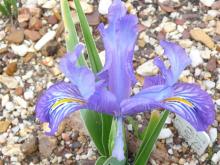
It was grown from seed and even produced a pod itself last year!
cheers
fermi
Re: Iris 2011
Are those cumquats?
Re: Iris 2011
Hello Tom, and welcome to the NARGS forum! Very glad you stopped in. I looked at your website, too, and am impressed. I went to bookmark it, and found I already had it bookmarked! (So many good sites I don't want to forget - but I do anyway!) your site kinda says you started with iris only in 2010. But your knowledge indicates a much longer iris love affair. Did you garden somewhere else previously?
Re: Iris 2011
Are those cumquats?
Hi Tom,
no they are fruit of the Mexican Hawthorn (Crataegus pubescens, syn CC mexicana, stipulacea).
cheers
fermi
Re: Iris 2011
A Dwarf bearded iris raised in NZ by Jean Stevens and named for her home town is "Wanganui Gem"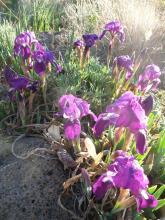
cheers
fermi
Re: Iris 2011
Fermi, my best bulb catalog carries some of the Iris reticulatas you mentioned, like Pixie and Natascha, but unfortunately not Pauline. Looks like a wonderful little iris.
Re: Iris 2011
Iris retic. 'Pauline' is quite common in the UK as is 'Natascha' but I never have any luck with it.
Re: Iris 2011
Hi Rick! Thanks for your kind words. I've gardened all my life; been in and out of the iris world several times since the 1970s. It seems that whenever I get a serious garden going, I end up having to move and give it up! Things should be more stable now...

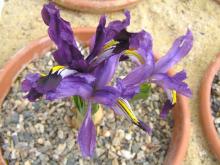
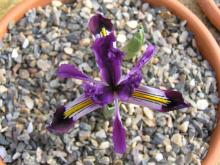

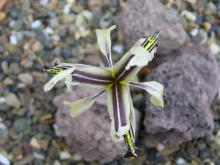
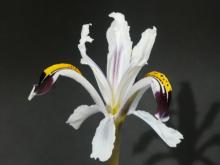
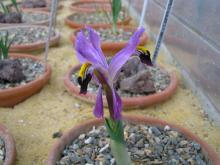
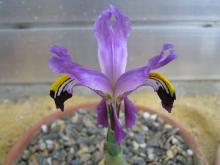
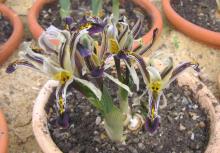
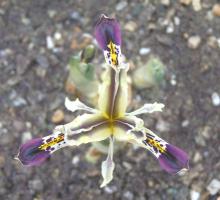
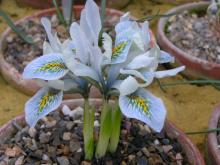
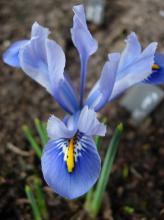
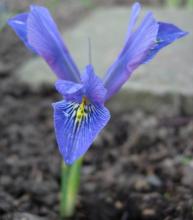
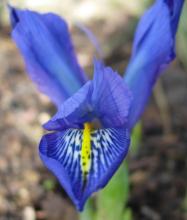
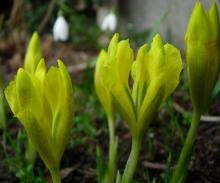
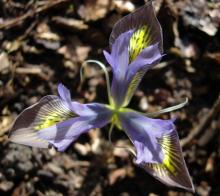
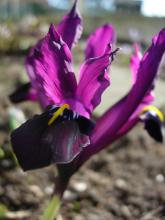
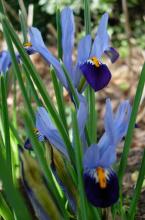
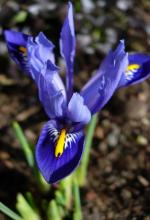
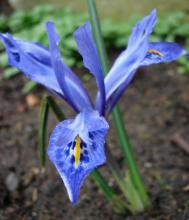

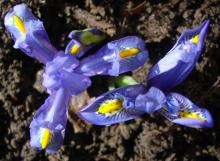
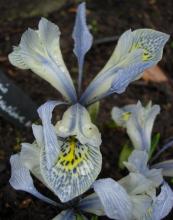
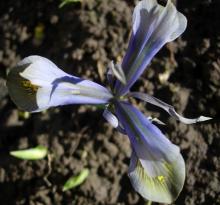
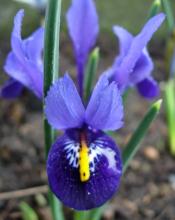
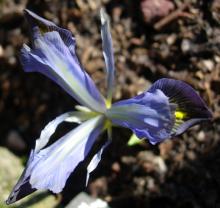
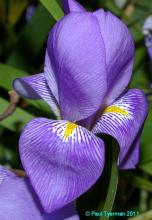
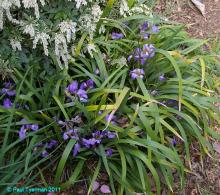
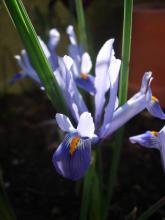
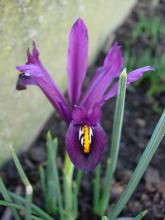
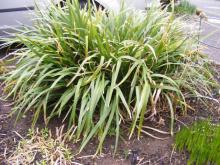
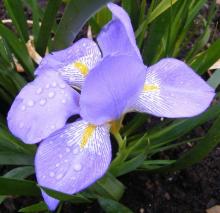

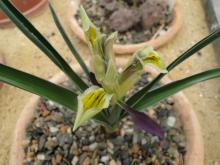
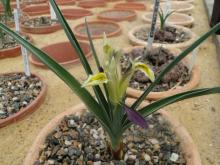
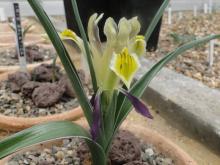
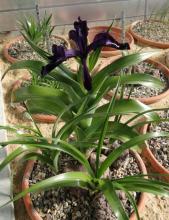
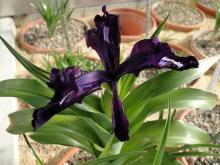
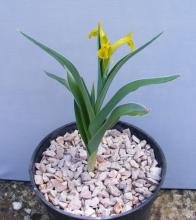
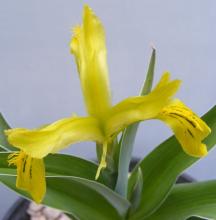
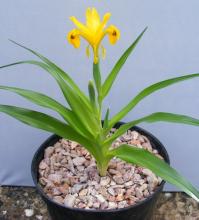

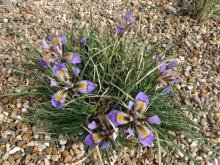
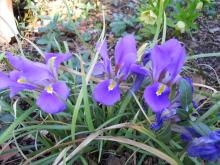
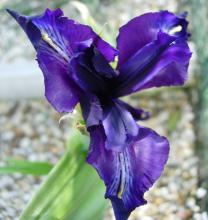
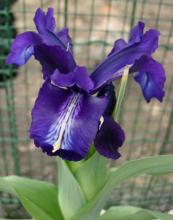
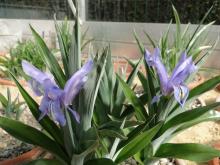

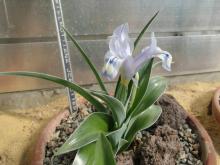
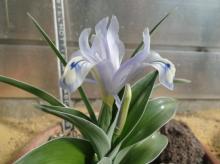
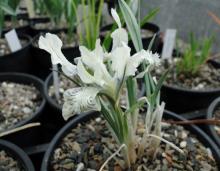
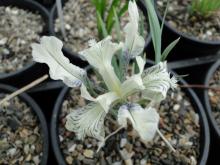
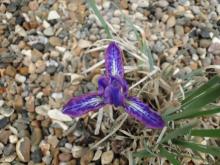
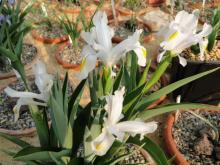
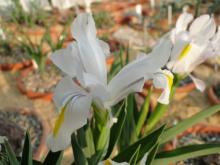
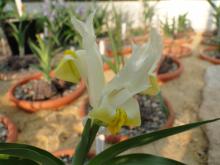
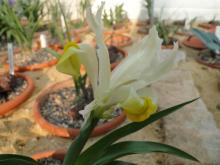
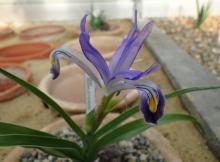
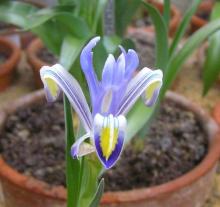
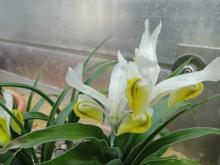
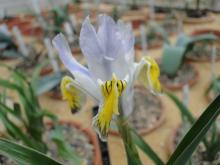
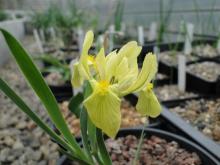
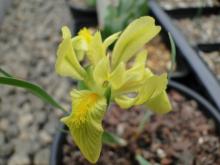
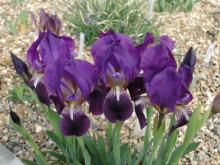
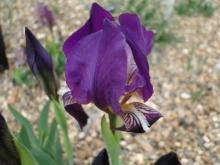
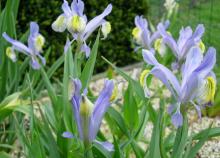
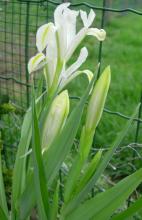
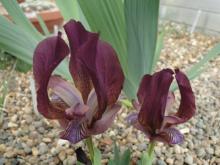
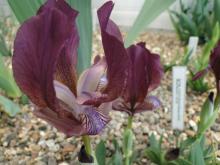
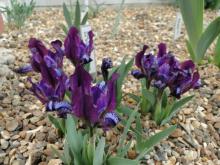
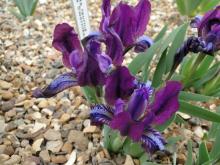
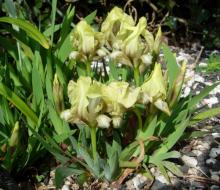
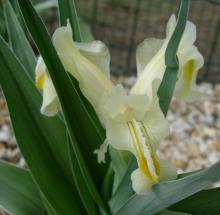
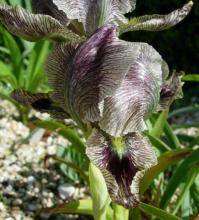
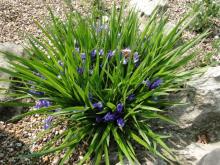
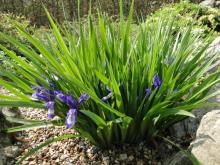
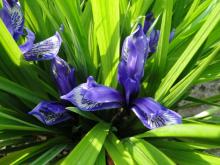
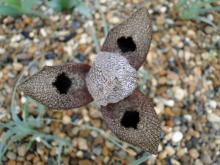

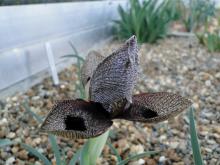
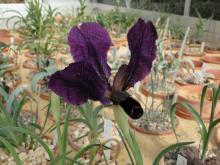
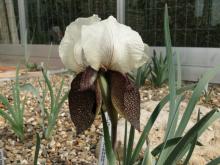
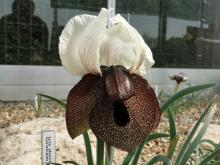
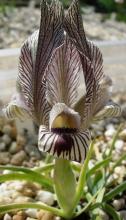

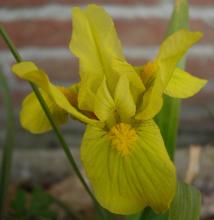
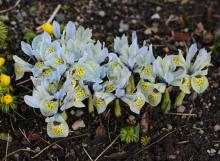
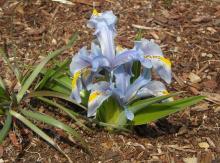
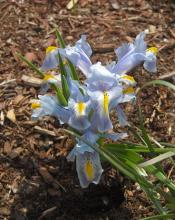
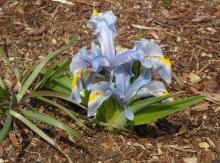
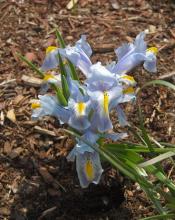
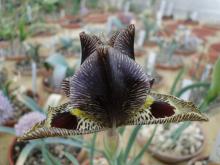
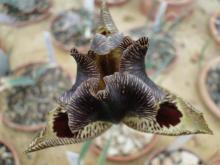
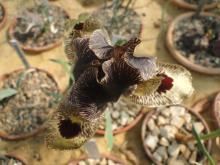
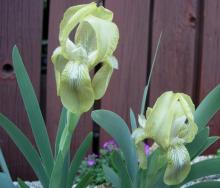
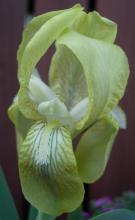
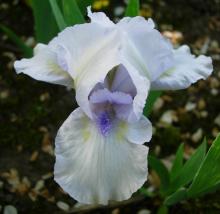
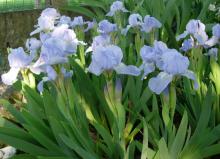
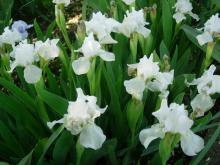
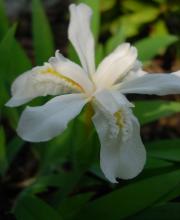
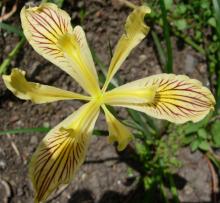
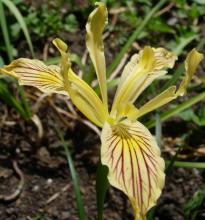
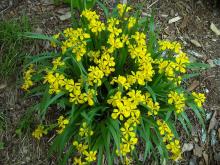
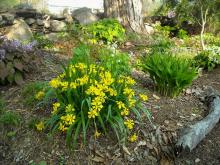

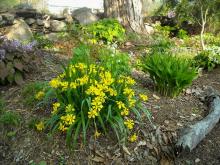
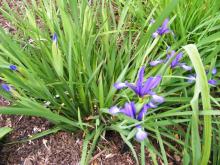
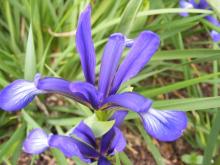
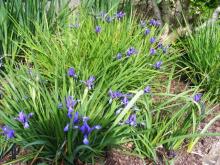
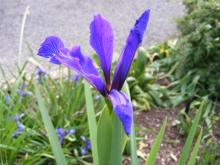
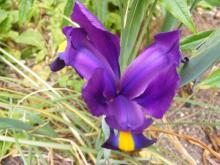
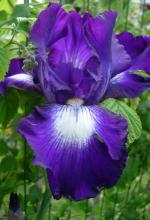
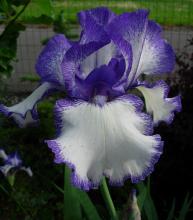
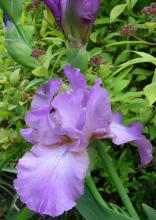
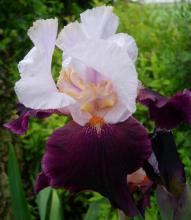
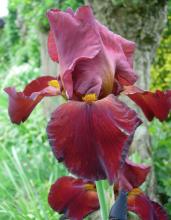
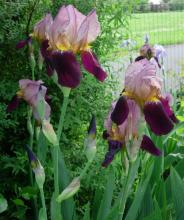
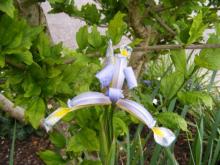
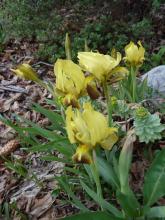
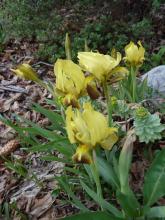
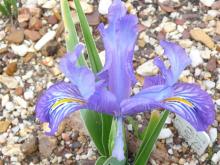
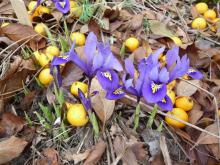
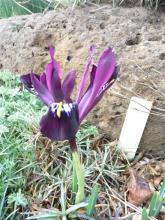
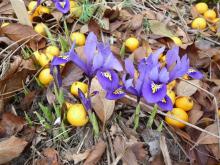
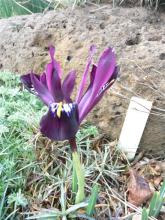
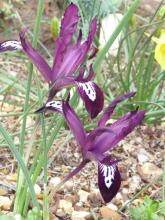
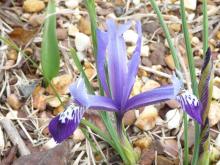
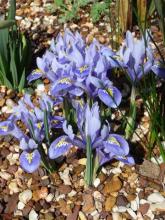
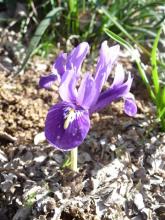
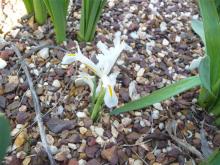
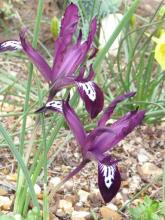
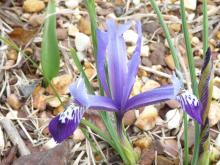
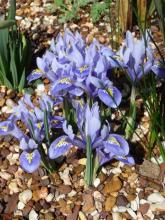
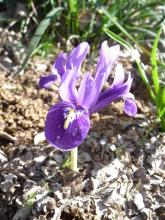
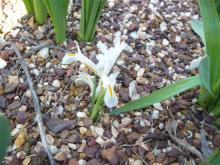
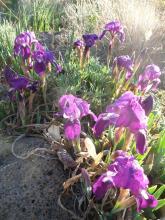
From an other section is iris (histrioides x winogradowii) "Frank Elder", a sister seedling of the better known "Katherine Hodgkin"